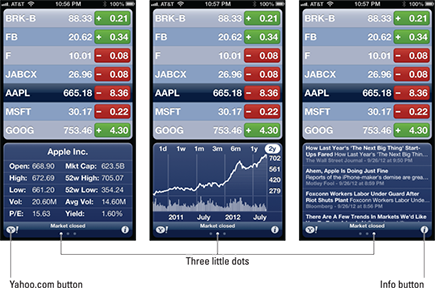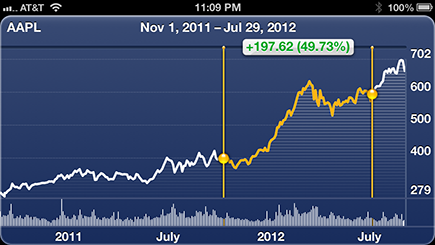Taking Stock with Stocks
Stocks is another Internet-enabled app on your iPhone. It’s kind of a one-trick pony, but if you need its trick — information about specific stocks — it’s a winner.
Every time you open the Stocks app by tapping its icon (on the second Home screen by default), it displays the latest price for your stocks, with two provisos:
![]() The quotes are provided in real-time; in earlier versions of iOS, they were delayed by up to 20 minutes.
The quotes are provided in real-time; in earlier versions of iOS, they were delayed by up to 20 minutes.
![]() The quotes are updated only if your iPhone can connect to the Internet via either Wi-Fi or a wireless data network.
The quotes are updated only if your iPhone can connect to the Internet via either Wi-Fi or a wireless data network.
So tap that Stocks icon and take a peek. The first time you open Stocks, you see information for a group of default stocks, funds, and indexes. You can’t see them all on the screen at once, so flick upward to scroll down.
Your stocks also appear by default in Notification Center (swipe down from the top of the screen). If you don’t see them in your Notification Center, tap Settings⇒Notifications⇒Stock Widget to enable them.
Adding and deleting stocks, funds, and indexes
Your chance of owning that exact group of stocks, funds, and indexes displayed on the screen is slim, so this section shows you how to add your own stocks, funds, or indexes and delete any or all default ones if you want.
Here’s how to add a stock, a fund, or an index:
1. Tap the i button in the bottom-right corner of the initial Stocks screen.
The i is for info.
2. Tap the + button in the top-left corner of the Stocks screen.
3. Type the stock symbol or the name of the company, index, or fund.
4. Tap the Search button.
The Stocks app finds the company or companies that match your search request.
5. Tap the stock, fund, or index that you want to add.
6. Repeat Steps 4 and 5 until you’ve finished adding stocks, funds, and indexes.
7. Tap the Done button in the top-right corner.
And here’s how to delete a stock (the steps for deleting a fund or an index are the same):
1. Tap the i button in the bottom-right corner of the initial Stocks screen.
2. Tap the – button to the left of the stock’s name.
3. Tap the Delete button that appears to the right of the stock’s name.
4. Repeat Steps 2 and 3 until you’ve deleted all unwanted stocks.
5. Tap the Done button.
That’s all there is to adding and deleting stocks.
 To change the order of the list, tap the i button and then drag the three horizontal lines to the right of the stock, fund, or index up or down to its new place in the list.
To change the order of the list, tap the i button and then drag the three horizontal lines to the right of the stock, fund, or index up or down to its new place in the list.
Details, details, details
To see the details for an item, tap its name to select it and the lower portion of the screen will offer additional information. Note the three small dots under the words Market Closed. These dots tell you that three screens of information are available, all shown in Figure 13-14. To switch between these three screens, simply swipe to the left or the right on the lower part of the screen.

Figure 13-14: The Stocks screens.
To look up additional information about a stock at Yahoo.com, first tap the stock’s name to select it, and then tap the Y! button in the lower-left corner of the screen. Safari launches and displays the Yahoo.com finance page for that stock.
Charting a course
Referring to Figure 13-14, note the chart at the bottom of the middle image. At the top of the chart, you see a bunch of numbers and letters, namely 1d, 1w, 1m, 3m, 6m, 1y, and 2y. They stand for 1 day, 1 week, 1 month, 3 months, 6 months, 1 year, and 2 years, respectively. Tap one of them and the chart updates to reflect that period of time. (In Figure 13-14, 2y is selected.)
That feature is sweet but here’s an even sweeter one: If you rotate your iPhone 90 degrees, the chart appears in full-screen, as shown in Figure 13-15. Here are three cool things you can do with full-screen charts:
![]() Touch any point in time to see the value for that day.
Touch any point in time to see the value for that day.
![]() Use two fingers to touch any two points in time to see the difference in values between those two days, as shown in Figure 13-15.
Use two fingers to touch any two points in time to see the difference in values between those two days, as shown in Figure 13-15.
![]() Swipe left or right to see the chart for another stock, fund, or index.
Swipe left or right to see the chart for another stock, fund, or index.

Figure 13-15: Use two fingers to see the difference in values ($197.62, or 49.73%) between two dates (November 1, 2011, and July 29, 2012).
By default, the Stocks app displays the change in a stock’s price in dollars. You can instead see the change expressed as a percentage or as the stock’s market capitalization. Simply tap the number next to any stock (green numbers are positive; red numbers are negative) to toggle the display for all stocks — dollar change, percent change, market cap. So if your stocks, funds, and indexes are currently displayed as dollars, tapping any one of them switches them all to percent — and tapping again switches them to market cap.
Another method requires more steps: Tap the i button in the bottom-right corner of the initial Stocks screen. Then tap the %, Price, or Mkt Cap button at the bottom of the screen. The values are then displayed in the manner you chose. Tap the Done button in the top-right corner when you’re finished.
